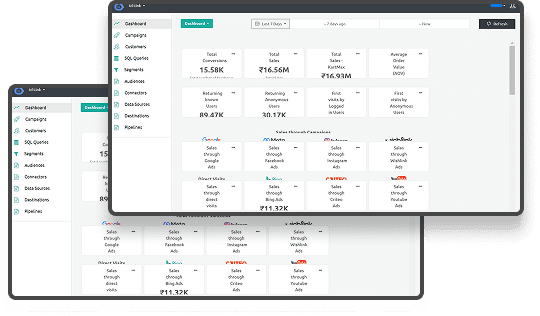Developing Best Practices for First-Party Identity Infrastructure
Alright, let's dive into the wild world of first-party identity! Imagine we're chilling at a digital café, talking about websites and how they get to know us. It's getting kinda weird out there, right? Cookies are crumbling, privacy is a hot topic, and suddenly, businesses are scratching their heads, going, "Wait, how do we even talk to our own customers anymore?"
That's where first-party identity infrastructure steps in, like that friendly barista who knows your name and your usual order, making you feel right at home.
Let's get comfy and chat about why this is suddenly THE thing and how to actually build it without making things a total mess.
Why First-Party Identity is Now a Must-Have
In the not-so-distant past, businesses relied heavily on third-party cookies to track users across the web. These cookies worked like digital stickers, following users from one site to another and giving marketers insights into their behavior across multiple platforms.
However, privacy laws like GDPR and CCPA, alongside browser changes (e.g., Apple’s new privacy features), are rendering cookies obsolete. As a result, businesses are facing a loss of detailed user-level data and must now find alternative ways to reach their customers.
Why First-Party Identity is the Answer
First-party identity is built from data you collect directly from your customers, like through your website, app, or CRM system. This is a shift away from external tracking and allows businesses to form more personal, meaningful connections with their audience.
Benefits of First-Party Identity
- Privacy-Friendly: You’re collecting data directly from users with their consent, making this method more transparent and compliant with privacy regulations.
- Control: You own the data, which means you control how it’s used, providing more security and flexibility.
- Stronger Customer Relationships: By directly engaging with customers, you can build trust, tailor experiences, and better understand their preferences.
- Future-Proofing: With growing privacy concerns, first-party identity is becoming the gold standard for businesses seeking long-term, sustainable marketing strategies.
- Better User Experiences: When done right, first-party data allows for personalized experiences that customers actually appreciate, rather than feeling like they’re being stalked online.
Think of examples you probably already encounter daily:
- Logging into your favorite online store: You create an account, you give them your email, maybe your address, preferences. That's first-party data in action.
- Subscribing to a newsletter: You're explicitly giving them your email in exchange for content. First-party!
- Completing a profile on a social media site: You tell them about yourself directly. Guess what? First-party!
- Using a website's live chat feature: You're directly engaging, sharing information in real-time. First-party gold!
Basically, anything where a customer directly interacts with you and willingly shares information is building first-party identity.
How to Build a Strong First-Party Identity Infrastructure
Building your first-party identity infrastructure is like constructing a house. It requires a solid foundation, sturdy walls, a protective roof, and a well-maintained interior. Let’s break it down:
1. Foundation: Consent and Transparency
The foundation of your first-party identity lies in trust. You must be transparent with users about what data you’re collecting, why, and how it will be used. Here’s how:
- Clear Privacy Policies: Avoid legal jargon. Instead, write clear, easy-to-understand policies that explain what data is being collected and how users can control it.
- Meaningful Consent Mechanisms: Make it easy for users to give and withdraw consent. Use simple checkboxes or toggle buttons.
- Value Exchange: Explain the benefits of sharing data, such as personalized experiences or exclusive content.
- Transparency Everywhere: Make sure users understand how their data will be used at every point of collection—whether through forms, sign-ups, or behavior tracking.
For more on privacy policies and user consent, you can explore our article on What You Need to Know About Consent Management.
2. Walls: Data Security and Privacy Protection
Now that you’ve built a solid foundation, it’s time to protect that data like it’s gold.
- Robust Security Measures: Use encryption, access controls, and regular security audits to safeguard user data.
- Privacy by Design: Build privacy into your systems from the ground up. Use practices like data minimization (collect only necessary data), anonymization, and clear data retention policies.
- Compliance: Stay on top of privacy regulations like GDPR and CCPA to avoid penalties and maintain trust.
- Data Governance: Establish rules for how data is accessed, used, and stored within your organization.
Looking for tips on privacy regulations and how to stay compliant? check out Understanding the General Data Protection Regulation (GDPR).
3. Roof: User Experience and Value Delivery
The roof keeps everything safe and makes the home comfortable. Similarly, your first-party identity infrastructure must provide value and be easy for users to interact with.
- Seamless User Experience: Make it easy for users to manage their data and preferences, and ensure the process is user-friendly.
- Personalized Experiences: Use first-party data to deliver tailored content, recommendations, and a smoother journey for the user.
- Respect User Preferences: If a user opts out, respect their decision. Make sure they can easily change their preferences without hassle.
- Consistent Experience Across Channels: Whether interacting on your website, app, or social media, a user’s identity and preferences should be consistent across all touchpoints.
4. Interior Design: Data Management and Infrastructure
Inside your house, you need functional systems like plumbing and electricity. Your first-party identity system needs solid data management to ensure everything flows smoothly.
- Centralized Identity Platform: Consider using a Customer Identity and Access Management (CIAM) platform to centralize all user data, consent, and profiles for easier management.
- Data Integration: Connect your first-party data to other systems like CRM, marketing automation, and analytics for more streamlined operations.
- Scalability: Plan for growth. Your infrastructure should be able to scale as your business and user base grow.
- Data Quality: Make sure the data you collect is accurate and up-to-date. Implement data validation and cleansing processes to maintain high-quality data.
Looking for more on data integration and how to manage user identities? visit our blog on What is a Customer Data Platform?.
5. Landscaping & Curb Appeal: Ongoing Communication and Relationship Building
Just like how a well-maintained garden enhances a home’s appearance, ongoing communication and relationship-building enhance your first-party identity infrastructure.
- Regular Communication: Don’t just collect data and disappear. Stay in touch with your users through newsletters, personalized emails, and community engagement.
- Feedback Loops: Actively solicit feedback from your customers on their experiences and how you’re using their data.
- Build Long-Term Trust: Consistently handle user data with care and respect, ensuring a long-term relationship built on trust.
- Adapt and Evolve: Stay informed about changes in privacy laws and user expectations, and adapt your practices accordingly.
How Ingest Labs Provides Support
Ingest Labs makes it easier to develop and manage an effective first-party identity graph with a robust server-side tag management system. Here’s how we can help:
- Data Integration: Ingest Labs integrates seamlessly with over 80 platforms to collect first-party data across all touchpoints, making it easy to build a comprehensive identity graph.
- Privacy and Compliance: We ensure that your data collection practices comply with global privacy regulations like GDPR, CCPA, and PIPEDA. Our tools help you manage consent efficiently and maintain ethical data practices.
- Real-Time Data Streaming: Our real-time data streaming features allow you to update your identity graph instantly, ensuring that your marketing campaigns always use the most current and relevant customer information.
- Advanced Tagging and Attribution: Ingest Labs provides server-side tagging that tracks key events like Add to Cart, Checkout, and Purchase, and attributes them to the right customer profiles in your identity graph.
For more information on how Ingest Labs can help with your identity graph and first-party data strategy, explore our post on How Ethical Data Collection Builds Trust and Fuels Business Growth.
Conclusion
Building a strong first-party identity infrastructure is not just about collecting data. It's about building trust, respecting privacy, delivering value, and creating meaningful relationships with your customers. It's a long-term investment that pays off in better experiences, stronger loyalty, and a more sustainable business in a privacy-first world.
So, take a deep breath, grab your digital tools, and start building your first-party fortress. It might seem like a lot of work, but trust me, in the long run, you'll be glad you did. And your customers will appreciate it too! Cheers to a more human and privacy-respecting internet!
Ready to enhance your marketing efforts? Contact Ingest Labs today to learn how our solutions can help you build a more effective and privacy-compliant identity infrastructure.






